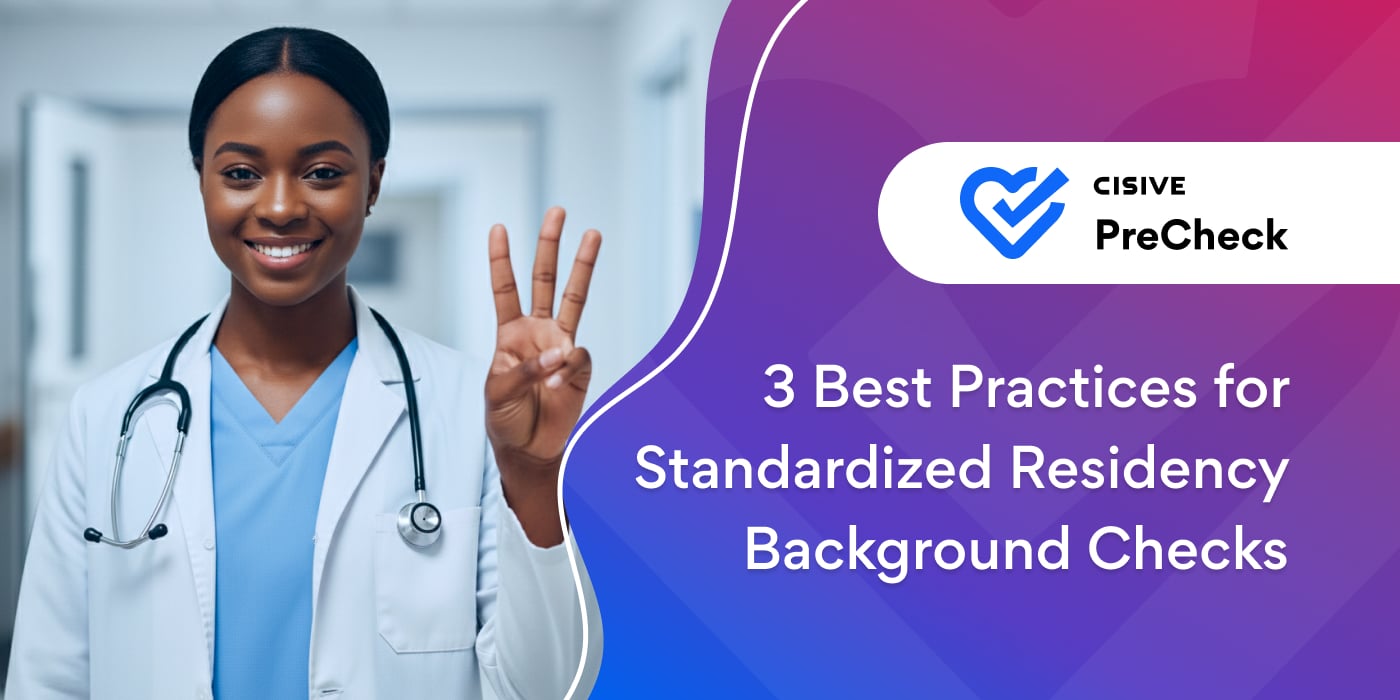

In this Product Highlight, we’ll review key tools to consider in your screening program, as well as...

Every year, thousands of medical students transition into residency programs. This watershed moment in their career should be a highlight, but it often brings compliance and onboarding challenges.
Inconsistent background check processes across states, departments, or affiliated institutions can create numerous issues for students and institutions. A student who clears the onboarding process at one hospital may face a restart at another due to mismatched screening protocols. Among the most common consequences are delayed start dates, compliance lapses, and friction between program coordinators and HR teams.
Meanwhile, the administrative strain of screening these candidates can quickly multiply for healthcare systems, especially those managing multiple teaching hospitals or clinical rotation sites. When every location defines “compliance” differently, nobody wins. Disjointed background check procedures slow down placement, increase administrative burden, and introduce real risk to your workforce strategy.
Healthcare organizations must conduct background checks on all incoming residents to ensure safety and compliance across all health care providers.
In high-stakes, highly regulated environments like health care, even minor misalignments in screening practices can have outsized consequences. Standardizing the medical residency background check process is a critical step to enhance operational efficiency, regulatory consistency, and patient safety and trust in health care providers.
Residency programs share a common goal of ensuring that incoming residents are qualified and compliant. But in practice, the medical student background check process can vary widely between locations.
Some hospitals require a full seven-year criminal background check for medical students. Others also require fingerprinting or unique drug-testing protocols. Even basic tasks like immunization verification can differ, depending on whether a site accepts self-attestation or mandates third-party review.
Despite these inconsistencies, most national background checks include core elements: state and federal criminal records screening, OIG and SAM exclusion checks, identity verification, drug testing, and immunization tracking. The biggest challenge is the inconsistent execution of background checks, which creates delays, duplicate screenings, and unnecessary risk.
When healthcare systems attempt to unify background check processes, they can encounter structural roadblocks. Two of the biggest are legal variability and institutional autonomy.
Regulations governing background checks can differ by state, city or county, and health system. Some jurisdictions limit how many years back certain records can be reviewed, while others require specific screenings for healthcare workers. These discrepancies make it difficult to apply a single policy across residency sites without running afoul of local or state laws.
Even within a single organization, policies can vary based on legacy systems, department preferences, or historic relationships with clinical partners. One facility might use a preferred vendor with its own verification protocols, while another follows state university guidelines. Some departments may request additional or specialized background check reports, further complicating standardization efforts. Attempting to align these processes can trigger internal resistance, especially if stakeholders fear losing control over compliance or onboarding workflows.

Standardizing background checks across medical residency sites requires building a framework that respects local compliance while ensuring consistent information is reported. A standardized process should include clear instructions for applicants to submit their required documents and information for background screening. These best practices can help healthcare systems create a centralized, scalable process that works across departments and locations.
Start by defining a core screening package that applies system-wide. Cover essentials like criminal history search, exclusion lists, identity verification, drug testing, and immunization tracking. The policy should also include steps to ascertain the accuracy of all information collected during the background check process. Then create site-specific add-ons for locations with additional legal or contractual requirements. This “core-plus” model creates consistency while respecting local differences.
StudentCheck, for example, supports this approach by offering pre-built program packages tailored to institutional needs. Beyond that, individual clinical sites can configure their options to obtain additional information. This ensures that every student is screened to the baseline standard while allowing for localized compliance adaptations.
Chief HR officers, program directors, compliance officers, and legal teams each play a role in standardizing background check report workflows. Without early buy-in, even the best-designed screening process can stall. Include these stakeholders when developing policy, selecting vendors, and rolling out systems. Their input can contribute to a process that’s defensible and enforceable. When looking for an external background check provider, seek a team with deep expertise in healthcare background checks.
Manual tracking via spreadsheets, email chains, or siloed systems is a major source of errors and onboarding delays. The most efficient programs rely on platforms like StudentCheck that integrate all background screening components into a single, secure portal. These platforms provide 24/7 access, automated alerts, and real-time compliance visibility. Program administrators no longer need to chase paperwork or interpret fragmented records.

Technology is essential for standardizing background checks across residency sites. Three tools make the biggest impact: online screening platforms, centralized data systems, and clinical rotation management systems.
Platforms like StudentCheck bring all screening components—criminal checks, drug testing, immunization tracking—into a single, intuitive interface. Administrators can monitor progress in real time, configure site-specific requirements, and reduce paperwork across the board.
Mobile access and automated alerts, meanwhile, simplify the process for medical students and reduce errors. Every record is reviewed by a health record professional, ensuring accuracy and compliance before clinical placement. These platforms must also ensure the protection of confidential information throughout the screening process.
With centralized reporting, program leaders can track compliance by location, identify bottlenecks, and stay audit-ready.
Look for a platform that offers real-time dashboards and customized reports. These give your team consistent visibility while adapting to each site’s requirements.
Platforms like MyClinicalExchange streamline scheduling, onboarding, and compliance tracking across multiple residency sites. By centralizing requirements and communication, they reduce administrative burdens, minimize errors, and ensure every student meets site-specific criteria.
Standardizing this technology across programs helps create consistent experiences for students and keeps institutions aligned with regulatory and partner expectations.
Standardizing medical residency background checks across locations is both an operational improvement and a strategic advantage. It reduces administrative burden, accelerates onboarding, strengthens compliance, and ensures every student is fully vetted and ready to contribute from day one.
In a fragmented regulatory landscape, healthcare systems need screening processes that are consistent and adaptable. With the right policy framework and technology, it’s possible to support diverse clinical partners while maintaining centralized oversight and control.
StudentCheck was built for this complexity. From configurable screening packages to real-time reporting and expert document review, StudentCheck gives healthcare organizations the tools to streamline onboarding without cutting corners.
Ready to simplify and standardize your residency screening process? Talk to a PreCheck expert today and explore how StudentCheck can support your team.
Author: Christine Kowalewski
Bio: Student Healthcare Screening Expert at Cisive.
Let's Connect on LinkedIn
In this Product Highlight, we’ll review key tools to consider in your screening program, as well as...

If your organization hires nurses, you already know the stakes: One overlooked license issue or...

Do you trust the physical therapists you hire? They work directly with patients and need to deliver...